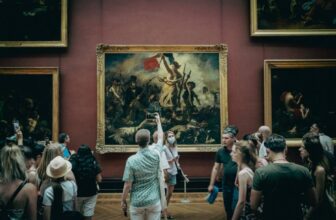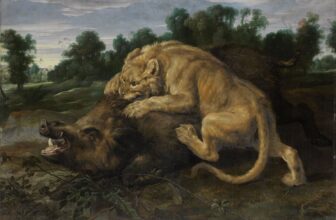
Meaning of The Song of Love Painting by Giorgio de Chirico
Giorgio de Chirico’s The Song of Love , Italian: Canto d’Amore, painted in 1914, stands as one of the most iconic works of early 20th-century art. It is a dreamlike, enigmatic composition that reflects the birth of a new artistic language, Metaphysical Art. With its surreal juxtaposition of objects, melancholic atmosphere, and classical references, The Song of Love encapsulates de Chirico’s unique vision, one that significantly influenced later movements such as Surrealism. This painting is not only a visual riddle but also a philosophical statement, exploring themes of memory, time, identity, and the unconscious.
In this article, we will delve into the genesis, symbolism, meaning, and cultural context of The Song of Love. We will also explore how it was created, what is happening within the scene, what kind of art it represents, and where the painting is located today.
Who Was Giorgio de Chirico?
Before understanding the painting, it’s important to know its creator. Giorgio de Chirico (1888–1978) was an Italian painter born in Volos, Greece, to Italian parents. Trained in Athens, Florence, and later at the Academy of Fine Arts in Munich, de Chirico was heavily influenced by classical art and philosophy, particularly the writings of Nietzsche, Arthur Schopenhauer, and German Romanticism.
By the early 1910s, de Chirico developed what came to be known as Metaphysical Painting, a style marked by empty urban landscapes, classical architecture, shadows cast at odd angles, and a dreamlike silence. These works aimed to capture what lay beyond physical appearances, evoking a deeper, often unsettling reality. The Song of Love was one of the earliest and most influential paintings from this pivotal period.
What Is The Song of Love Painting All About?
At first glance, The Song of Love may appear like a strange, almost nonsensical composition. It depicts a classical green wall to the left, upon which an oversized red rubber glove is mounted like a relic or sculpture. Next to the glove hangs a Greek sculpted head, resembling a bust of Apollo or perhaps a classical kouros. Behind these objects stands a large green ball, and in the background, we see the outlines of an architectural façade, a steam engine moving across the horizon, and a cloudless, turquoise sky.
The objects are not interacting in any traditional narrative sense. Instead, they are assembled as though in a dream, each with an autonomous presence that resists immediate interpretation. This strange assortment becomes the stage for profound metaphysical reflection. The painting is not about a particular event or story; rather, it evokes a mood, a haunting stillness, a feeling of nostalgic unease, and a confrontation with the unknown.
How Was The Song of Love Painted?
Giorgio de Chirico painted The Song of Love in 1914, during a period of profound artistic experimentation while he was living in Paris. This was shortly before the outbreak of World War I, a time of both cultural upheaval and philosophical questioning. The medium is oil on canvas, measuring approximately 73 cm by 59 cm (28.7 x 23.2 inches).
De Chirico worked deliberately, drawing on classical training in perspective and anatomy but applying it to surreal compositions. His technique in The Song of Love shows a careful balance between realism and abstraction. The shadows and architectural elements are rendered with precision, but the scale and placement of objects defy natural laws. The red glove, for instance, is painted with volumetric accuracy, yet it floats in an inexplicable context. This blend of traditional painting technique with avant-garde composition is what made de Chirico’s work so revolutionary.
Symbolism and Meaning in The Song of Love
1. The Red Glove
The most immediately striking object is the red rubber glove. It’s industrial, modern, and mass-produced, unlike the ancient bust it accompanies. It introduces an alien, almost uncanny element into the classical environment. The glove could symbolize the intrusion of modernity into the timeless realm of the ideal. Some critics have also linked it to the surrealist interest in fetish objects or as a symbol of human absence.
2. The Classical Bust
The bust, probably representing Apollo, the god of music, poetry, and rationality, anchors the painting in the world of ancient art and intellect. Yet, dislocated from its body and suspended inexplicably on a wall, it also suggests the dismembering of reason and the fragmentation of identity. This severed head is reminiscent of classical art but becomes eerie in its decontextualization.
3. The Green Ball
The green rubber ball, another object out of place, adds to the visual dissonance. It might evoke childhood, play, or sport, but in the still, solemn setting, it appears more as a symbol of lost innocence or forgotten memories. It adds a mysterious note, contrasting the rigidity of the architectural forms.
4. The Steam Engine
In the background, almost hidden, is the silhouette of a steam locomotive, an important motif in de Chirico’s early paintings. Trains often represented time, travel, and the unstoppable movement of history. Here, its presence seems ghostlike, almost like a memory fading into the horizon. It creates a temporal tension, suggesting a narrative outside the frame.
5. Architecture and Shadows
The harsh perspective and long shadows are hallmarks of de Chirico’s metaphysical cityscapes. They hint at late afternoon, the “magic hour” when reality becomes strange. The architecture reflects emptiness and permanence, contributing to the psychological disquiet. The shadows do not always correspond logically to a light source, enhancing the dreamlike atmosphere.
What Is Happening in The Song of Love?
Unlike narrative painting, The Song of Love does not depict an event in time. Instead, it presents a theatrical stage of symbols, where static objects interact through spatial relationships and associative meanings rather than cause and effect.
The composition resembles an irrational shrine, an altar where modernity, antiquity, industry, and childhood memories coexist in silence. There is no human presence, yet the glove and head evoke traces of humanity. The result is a tableau of existential stillness, where time appears suspended and reality becomes opaque.
This arrangement of seemingly unrelated objects forces viewers to interpret intuitively, emotionally, and philosophically. It opens up questions: Why are these items here? What do they mean together? Is this a memory, a dream, a hallucination?
What Type of Art Is The Song of Love?
The Song of Love belongs to Metaphysical Art (Pittura Metafisica), a movement de Chirico founded and which flourished briefly between 1910 and the early 1920s. Metaphysical Art sought to reveal the hidden, often unsettling essence behind everyday appearances.
This style is characterized by:
Juxtaposition of incongruent objects
Dreamlike stillness and silence
Classically inspired architecture and forms
Unnatural perspectives and long shadows
A sense of timelessness and estrangement
While not surrealism per se, Metaphysical Art is often seen as a direct precursor to Surrealism. In fact, André Breton, Max Ernst, and Salvador Dalí all cited de Chirico as a major influence. The Surrealists were drawn to the psychological depth and symbolic richness of his early works. The Song of Love became a prototype of how art could explore the subconscious through symbolic imagery.
The Influence of Nietzsche and Philosophy
De Chirico’s thinking was deeply influenced by Friedrich Nietzsche, particularly his ideas on eternal recurrence, the nature of time, and the metaphysical disquiet beneath appearances. Nietzsche’s famous phrase “It is only as an aesthetic phenomenon that existence and the world are eternally justified” encapsulates de Chirico’s approach.
In The Song of Love, this influence is evident in the melancholic beauty of the scene, the confrontation between timelessness and change, and the feeling that there is a deeper, hidden reality behind surface appearances. The painting doesn’t explain; it reveals that not everything must be understood rationally, some truths are poetic, emotional, intuitive.
Where Is The Song of Love Located Today?
Today, The Song of Love resides in The Museum of Modern Art (MoMA) in New York City. It is part of the museum’s permanent collection and is often on display in exhibitions relating to surrealism, modernism, and early 20th-century avant-garde movements.
The MoMA acquired the painting as part of its effort to represent pivotal moments in modern art history. It remains one of the most celebrated and frequently studied works in their collection.
Giorgio de Chirico’s The Song of Love is much more than an enigmatic arrangement of objects, it is a profound exploration of time, identity, memory, and the metaphysical realm. Painted on the eve of World War I, it captures a world in flux, where the past and future meet in surreal, symbolic silence.
The painting’s power lies not in telling a clear story but in provoking thought and emotion. It leaves space for the viewer to project meaning, to feel the disquiet, and to ponder the mysteries of existence. As one of the founding works of Metaphysical Art, The Song of Love continues to influence artists, philosophers, and dreamers over a century after its creation.
In a world driven by speed and superficial clarity, de Chirico’s painting invites us to pause, and to listen to the silent, eternal song of love that echoes through time and consciousness.




